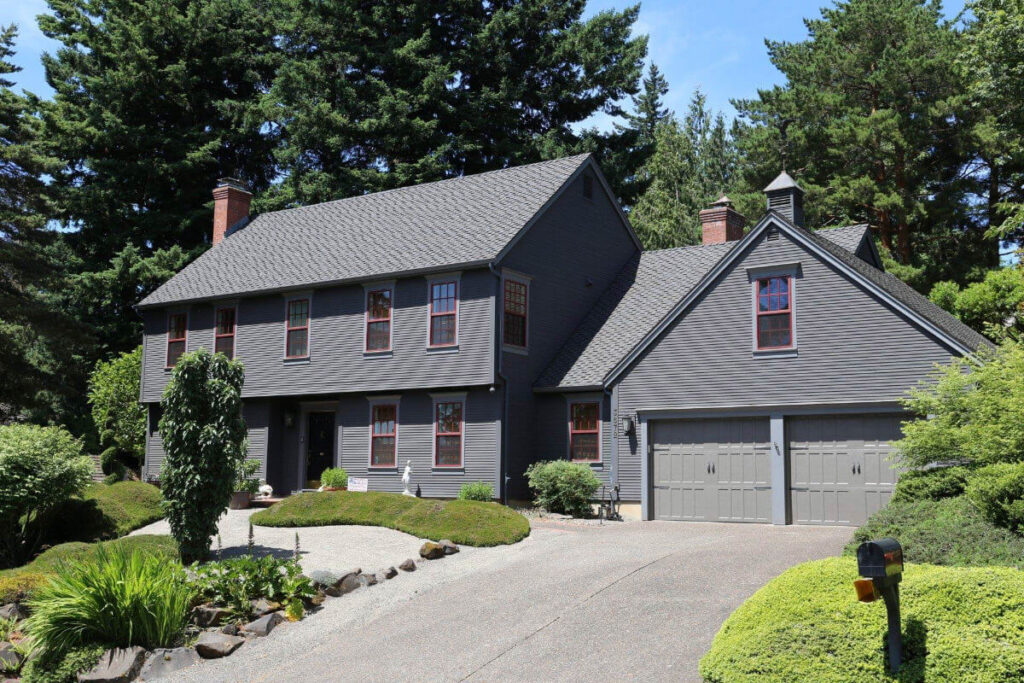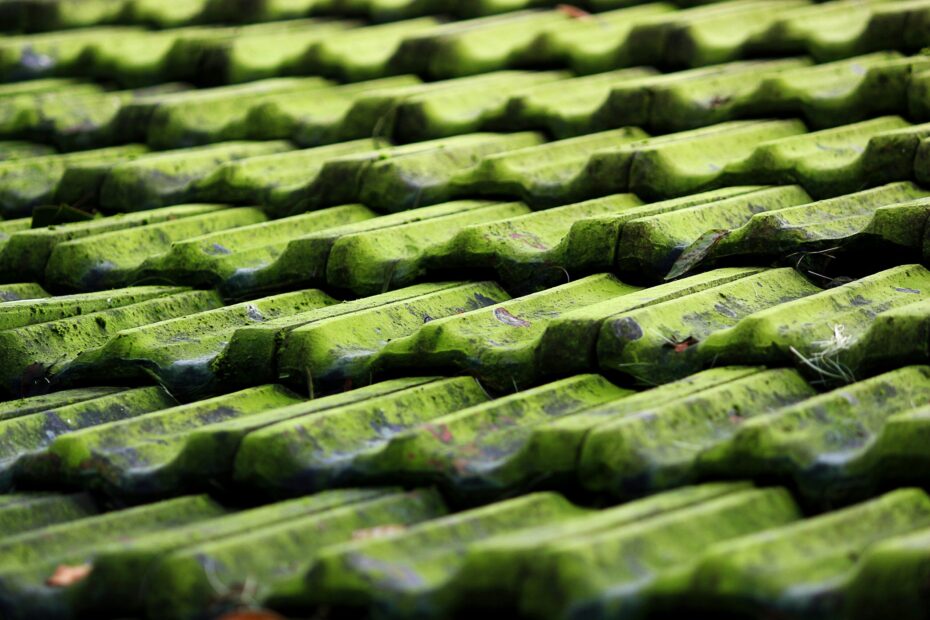After a wet winter, your roof becomes attractive to two common yet troublesome growths that can affect your roof’s integrity and appearance, moss and algae. Moss, with its spongy texture, traps moisture beneath shingles, leading to potential lifting and rot. On the other hand, algae, although less structurally damaging, create unsightly streaks that reduce your roof’s ability to reflect heat, thus increasing energy costs.
Understanding how to protect your roof from these persistent invaders is crucial. By maintaining a clean, dry roof and implementing preventive measures, homeowners can ensure their roofs remain healthy and moss-free, safeguarding their investment and enhancing their home’s comfort and energy efficiency. This guide will walk you through effective strategies for tackling and preventing moss and algae growth, ensuring your roof stays in optimal condition year-round.
Understanding the Dangers of Moss
Algae and moss are more than mere eyesores. With its spongy, green texture, moss can trap moisture beneath shingles. This results in lifted shingles which decay over time. Algae, though less immediately harmful, creates unsightly streaks and diminishes your roof’s heat-reflective capabilities, potentially increasing energy costs.
These organisms thrive in shady, moist environments where they can avoid the sun’s ultraviolet rays. Therefore, the north-facing parts of your roof and areas shaded by trees are particularly susceptible. Asphalt and wood shake shingles are especially vulnerable as they trap moisture and debris, creating an ideal environment for moss and algae growth.
Make your roof an inhospitable environment for these unwelcome guests to effectively combat the issues. Here’s a detailed guide on how to achieve that.
Keep Your Roof Clean and Dry
One of the most effective ways to prevent moss and algae growth is to maintain a clean and dry roof. Regular cleaning which includes removing debris and ensuring your gutters are clear, is a must. This enables water to flow freely and prevents the damp conditions in which moss thrives. in addition, trimming tree branches that overhang your roof can significantly reduce shaded areas, thus drying out those spots where moss is likely to grow.
Proper roof maintenance extends beyond merely cleaning it. Regular inspections by professional Portland roofing contractors are crucial in identifying potential problem areas before they become serious. Look for any signs of shingle damage, loose granules, or water pooling, as these can all contribute to possible algae and moss growth.
Use Metal to Avoid Moss Problems
You can install copper or zinc strips at the peak of your roof for a long-term fix. When rainwater washes over these strips, it carries tiny traces of metal down the roof, creating an environment that is hostile to moss. This simple addition can significantly reduce the likelihood of moss growth. Another option is to upgrade to algae-resistant shingles, which have metal particles embedded in them, offering long-term protection against these organisms.
Modern roofing materials are designed with durability and resistance to growths like moss and algae. When it’s time for a roof replacement, opt for materials that are less likely to harbor moisture and debris. Metal roofs, for example, are highly resistant to moss and algae due to their non-porous surface and the potential for metal ions to inhibit growth.
Safe Removal of Algae and Moss
If your roof is already affected by moss or algae, it’s important to remove them safely. Start by gently scraping away the growth using a soft-bristled brush on a long handle. Work from the top down to avoid lifting or damaging the shingles. This method is effective yet gentle enough to prevent further damage to your roof.
Aside from manual removal, using eco-friendly cleaning solutions is another option. A mixture of oxygen bleach and water can loosen and remove moss and algae effectively without harming your roof or the surrounding environment. Alternatively, a solution of white vinegar and water can also be used. Apply the solution with a sprayer, let it sit to loosen the growth, and then rinse thoroughly.
Making Safety a Priority
Prioritize safety before embarking on any roof cleaning project. Wear protective clothing and set up a sturdy ladder. Protect nearby plants from the chemicals of cleaning products by covering them with plastic sheeting. Avoid using a pressure washer, as the high-pressure water can strip away the granules on your shingles, leading to more roof problems.
Removing Moss on Shingles
While moss might seem like a harmless green blanket, it can trap moisture and damage your shingles. This is especially true for asphalt shingles, where moss can loosen the granules that protect them from the elements. To remove this unwanted guest, use a gentle approach. With a long-handled soft-bristled brush, carefully remove the moss, using light strokes and working from the top down to prevent lifting or damaging the shingles. Avoid power washing, as it’s too harsh for your roof’s delicate ecosystem.
After brushing off the moss, consider using a shingle cleaner designed specifically for this purpose. These cleaners help prevent future moss growth without harming your roof. Apply the cleaner according to the instructions and rinse with a gentle stream of water. Properly removing moss improves your roof’s appearance and extends its lifespan.
Addressing Your Mossy Mess
Many homeowners have concerns about dealing with moss and algae on their roofs. One common question is whether it’s possible to remove moss without damaging the shingles. The answer is yes, with gentle methods like soft washing with a shingle cleaner. Another concern is finding safe solutions for removing roof algae. Eco-friendly options that are effective and kind to your roof and the environment are available.
Consulting a roofing expert is the best course of action in severe cases. Professional Portland roofers can ensure thorough cleaning while protecting your roof’s warranty. If left untreated, persistent moss and algae growth can compromise your roofing materials, leading to repairs or a complete replacement. Addressing these issues promptly is crucial to maintaining your roof’s integrity.
When using bleach to kill moss and algae, be cautious. While effective, bleach can shorten the lifespan of your shingles and harm nearby plants. Safer alternatives like oxygen bleach or vinegar solutions are recommended. It’s essential to address moss and algae growth early to prevent increased moisture and mold, which can lead to expensive repairs.
Keeping Your Roof Moss-Free

Maintaining a moss and algae-free roof is not just about aesthetics; it’s crucial for the long-term health of your home. Ensuring proper ventilation in your attic with adequate soffit vents and a ridge vent helps dry out your roof and discourages moss and algae growth. Trimming tree branches that cast excessive shade over your roof allows more sunlight to reach it, helping it dry out and deter moss growth.
The pitch of your roof also plays a role. Steeper roof pitches are less likely to accumulate moss and algae. If you’re building or replacing a roof, consider a steeper pitch if it’s feasible within your area’s building codes and wind conditions.
For a more natural approach to moss removal, you can try using dry cornmeal, which absorbs moisture and creates an inhospitable environment for moss. Baking soda is another mild abrasive that can help loosen moss from shingles. Mix it with water to create a paste, apply to affected areas, scrub gently, and rinse thoroughly. Boiling water can also be effective; pour it carefully over moss patches to kill the moss. Work in small sections and avoid using excessively hot water to prevent damaging the shingles.
Making the Right Choice Between DIY and Professional Help
Deciding whether to tackle moss removal yourself or call in a roofing professional in Portland depends on several factors. For minor moss problems, DIY solutions may be sufficient. However, it’s best to consult a professional roofer for extensive moss growth. They have the experience and equipment to safely and effectively remove large amounts of moss without damaging your roof.
If your roof is steep or slippery, leave the moss removal to a professional. They have the proper safety gear and training to work on roofs at heights. Certain roof materials, such as slate or cedar shake, require special cleaning techniques. A professional roofer will know the best methods for cleaning your specific roof type without causing harm.
Preventive Measures to Extend the Life of Your Roof
You can keep your roof healthy and moss-free for a long time with the steps discussed. Regular roof inspections by a qualified Portland roofer can identify potential problems early on, such as moss growth or damaged shingles, and address them before they become more serious. Routine maintenance tasks like clearing debris from gutters and trimming overhanging branches help prevent moisture buildup and create a less hospitable environment for moss and algae growth.
Sometimes, moss and algae growth can be a symptom of a larger problem, such as poor ventilation or inadequate drainage. If you’re experiencing persistent moss growth, have a professional inspect your roof to identify and address any underlying causes.
By taking these preventive measures and maintaining a clean, dry, and well-ventilated roof, you can protect your home from the damaging effects of moss and algae growth. This will enhance the appearance of your roof, and ensure its longevity and structural integrity, keeping your home safe and comfortable for years to come.
